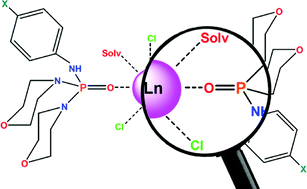A new family of isostructural early lanthanide(III) complexes (LnXPA) of the general formula Ln(XPA)2Cl3(solv)2, where Ln = La, Ce and Nd, XPA = (4-X-C6H4NH)P(O)(NC4H8O)2, X = H, F, Cl and Br, and solv = H2O and CH3OH, is introduced. X-ray crystallography shows that the replacement of the coordinated water by a methanol molecule may reduce the symmetry level of the unit cell from the orthorhombic crystal system and the space groupFdd2 to monoclinic and C2/c. DFT calculations, at B3LYP, PBE and B3PW91 levels, have been carried out to get a better insight into the structural, electronic and energy aspects of the compounds. The large cation attraction energy (−ΔE) values in the range 269–273 kcal mol−1, at the B3PW91/ECP/6-311+G** level for the model complexes XPA–La3+ with stoichiometry 1 : 1, represent new ligands XPA as efficient complexant agents for lanthanides. The electronic nature of para substituent X has no significant effect on the Ln–ligand bonding and cation affinity of the ligands XPA. The results of atoms in molecules (AIM) analysis reveal a partial covalent contribution of the Ln–ligand interaction for the models XPA–La3+ in the absence of counterions and coordinated solvents. In the real complexes LnXPA, a closed-shell Ln–ligand interaction is established. Increasing the charge difference between nitrogen and phosphorus atoms (by ∼0.06 e) associated with a weakening of the Lp(OP)→σ*(P–N) electronic delocalization (Lp(OP) being the lone pair of the phosphoryl oxygen atom) may lead to an increase in partial multiple bond character of the P–N bonds in coordinated ligands, agreeing with the increase in ν(P–N) and 2JPH coupling constant values. The changes in electron density (ρ) and electronic energy density (H(r)) values confirm these structural reorganizations upon complexation.


 Please wait while we load your content...
Please wait while we load your content...